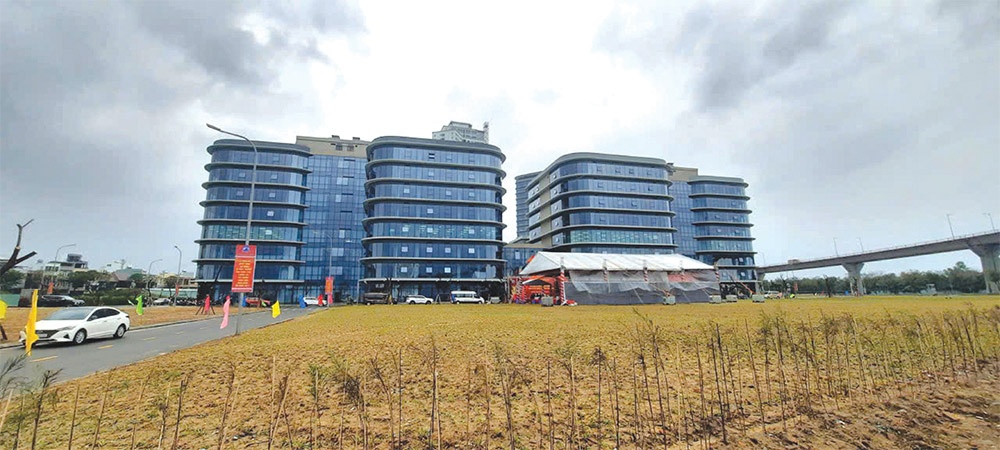 |
| Danang boasts over two dozen enterprises operating in design, testing, or packaging of microchips |
Danang Semiconductor Day on August 28 demonstrated the central city’s determination and aspiration to be a leader in the race to master core technology.
In particular, the launch of the $72 million Fab-Lab, a laboratory for the production of semiconductor packaging technology, was deemed an important step for Danang to strive to shape a semiconductor ecosystem with its own brand.
With an area of over 5,700 square metres, the initiative is divided into two main areas: a lab area focusing on research and development of new packaging technologies; and fabrication area, performing trial production with advanced equipment and international-standard systems.
After completion and operation, the scheme is expected to have a design capacity of about 10 million products annually, serving both domestic and international markets.
The project is funded by VSAP LAB under the leadership of Nguyen Bao Anh, a former technical director of Synopsys Vietnam in Danang, directly implementing chip designs for the world’s leading corporations.
Minister of Science and Technology Nguyen Manh Hung stated that Fab-Lab is a flexible coordination model between the state and enterprises, with the lab as a centre for testing innovation, laying the foundation for training high-quality human resources, attracting investment, and transferring technology.
Secretary of Danang Party Committee Luong Nguyen Minh Triet said, “VSAP Lab will be the nucleus to form a semiconductor innovation cluster, contributing to realising the aspiration of building Danang into a high-tech centre of the country and expecting to become a magnet attracting brainpower.”
In January, Danang set the goal of becoming one of the top three centres in the country in the semiconductor industry by 2030. The accompanying initiative aims to form a complete innovation ecosystem, focusing on training personnel, developing technology enterprises, and building a foundation for the industry.
In just a year, from eight initial enterprises, the city has now attracted 25 enterprises operating in either design, testing, or packaging. Leaders said this is the result of a methodical strategy involving clear orientation policies, gradually invested infrastructure, well-trained personnel, and a transparent investment environment.
The training sector has also recorded positive movements. There are nearly 10 universities and colleges in the Danang area enrolling students in the semiconductor microchip major with an initial scale of 600 students, which is expected to increase to 1,000 within the next year. The city has also organised several training courses for more than 250 lecturers and students, improving teaching and research capacity.
Danang aims to train at least 5,000 high-quality semiconductor engineers by 2030, including 2,000 design engineers and 3,000 packaging-testing engineers.
To realise this goal, Danang has made efforts to act. Firstly, the city created a policy framework in which students can borrow up to VND180 million ($7,200) in tuition fees, and are exempted entirely if they commit to working in Danang for at least three years after graduation. Experts can receive up to VND100 million ($4,000) per month and support for housing and innovation.
Along with that, Danang’s key universities have quickly adapted to new trends in the new era. The University of Technology (University of Danang) opened the Microelectronics-Microchip Design major from 2024, with training based on the programme standards issued by the Ministry of Education and Training.
The Vietnam-Korea University of Information Technology and Communications, University of Technical Education, and private universities such as Duy Tan and Dong A have all entered the race when it comes to crafting high-tech workers.
The schools are closely linked with businesses, from Cadence, Synopsys and FPT to Mixel and non-profit organisation TreSemi. Together, they have built labs and implemented physical design training classes, with the direct participation of international experts.
The DSAC Centre, the city’s microchip and AI research and training unit, is considered the pivot connecting such efforts. In less than two years, DSAC has trained more than 300 students and lecturers, organised dozens of intensive classes, and coordinated to support over two dozen technology startups operating in chips and AI at Software Park No.2.
There is also FPT and Marvell Vietnam – two units recognised by Danang as strategic partners. FPT not only plays a recruitment role for the latter, but also participates in building training programmes that meet business needs, contributing to creating a bridge between schools and the market.
Tran Dang Hoa, chairman of FPT Semiconductors at FPT Corporation, said that in the context of shifting global supply chains, Vietnam is emerging as a new destination. “In particular, Danang currently possesses all the conditions to take the lead in the semiconductor industry, with close coordination across state, school, and business,” Hoa said.
US Ambassador to Vietnam Marc E. Knapper said that the semiconductor industry is the foundation of the modern global economy, encouraging technological innovation and Industry 4.0.
“Vietnam, especially Danang, is in a favourable position to participate deeply in this value chain thanks to its rapidly developing economy, strategic location, increasingly high-quality workforce, and clear leadership vision,” Knapper said.
Vice Chairman of Danang People’s Committee Ho Quang Buu added, “The city has identified that creating a favourable environment for businesses to participate, encouraging startups in the microchip sector, and boosting investment in technology infrastructure and research and development are key factors.”




